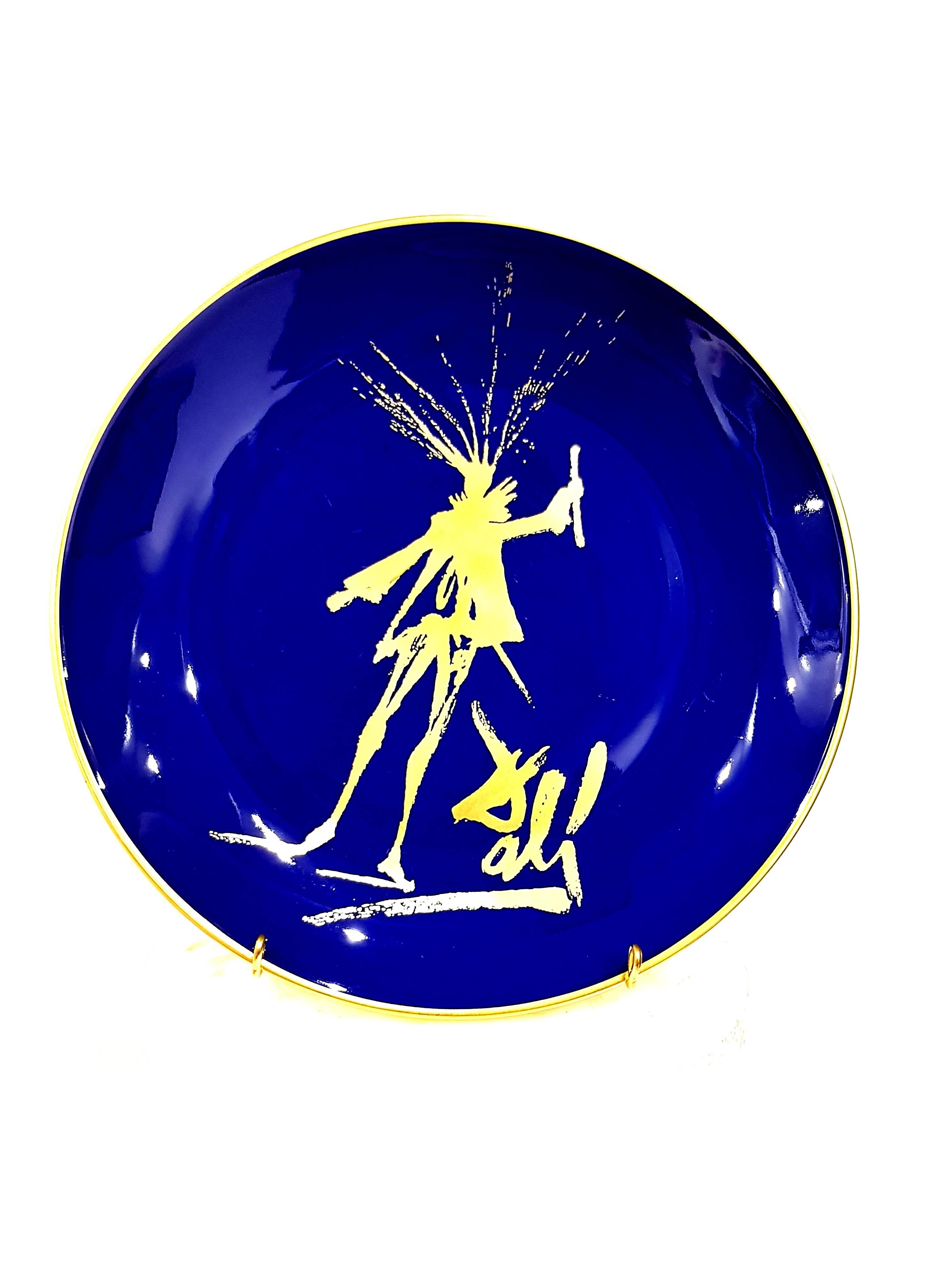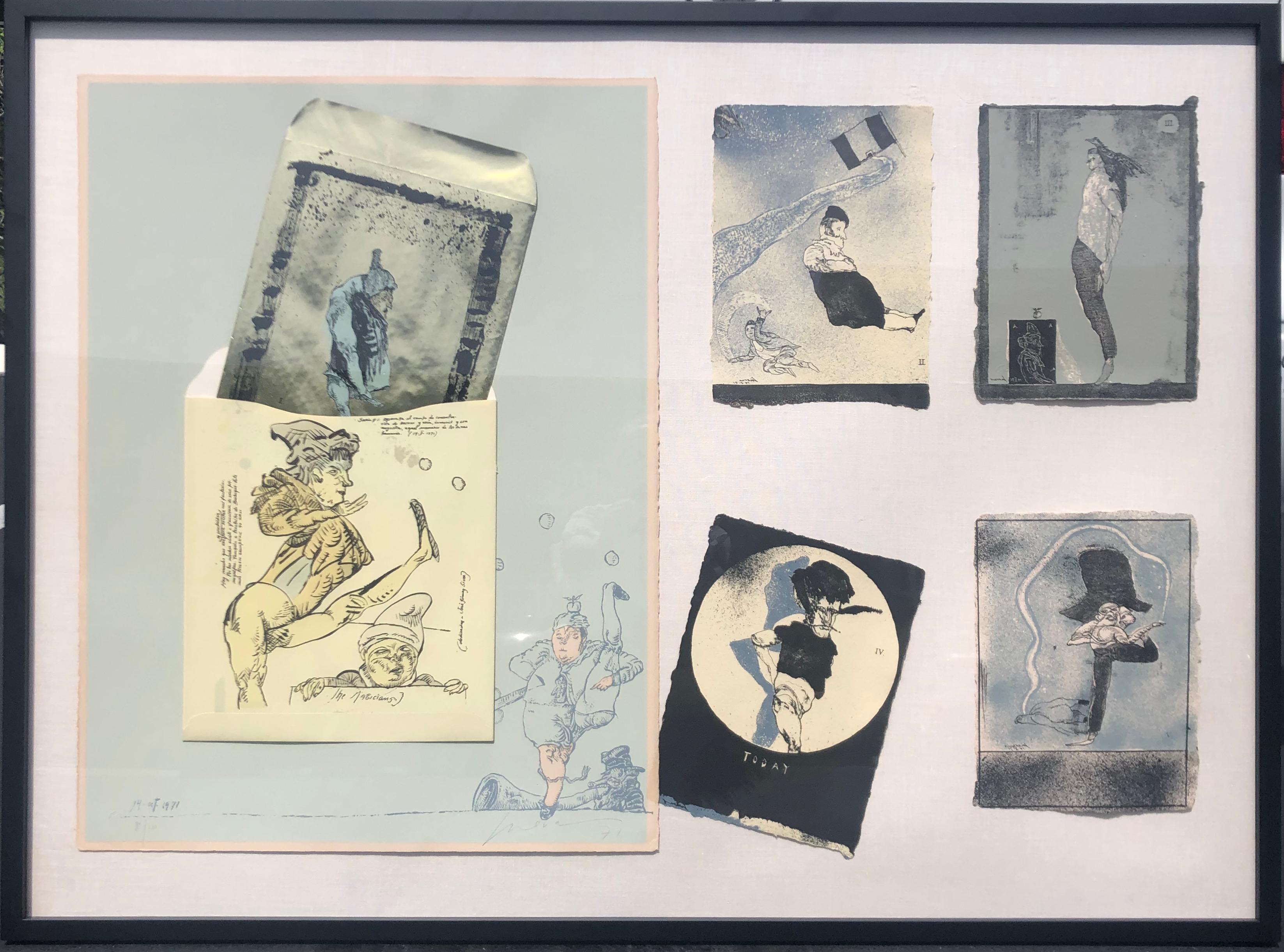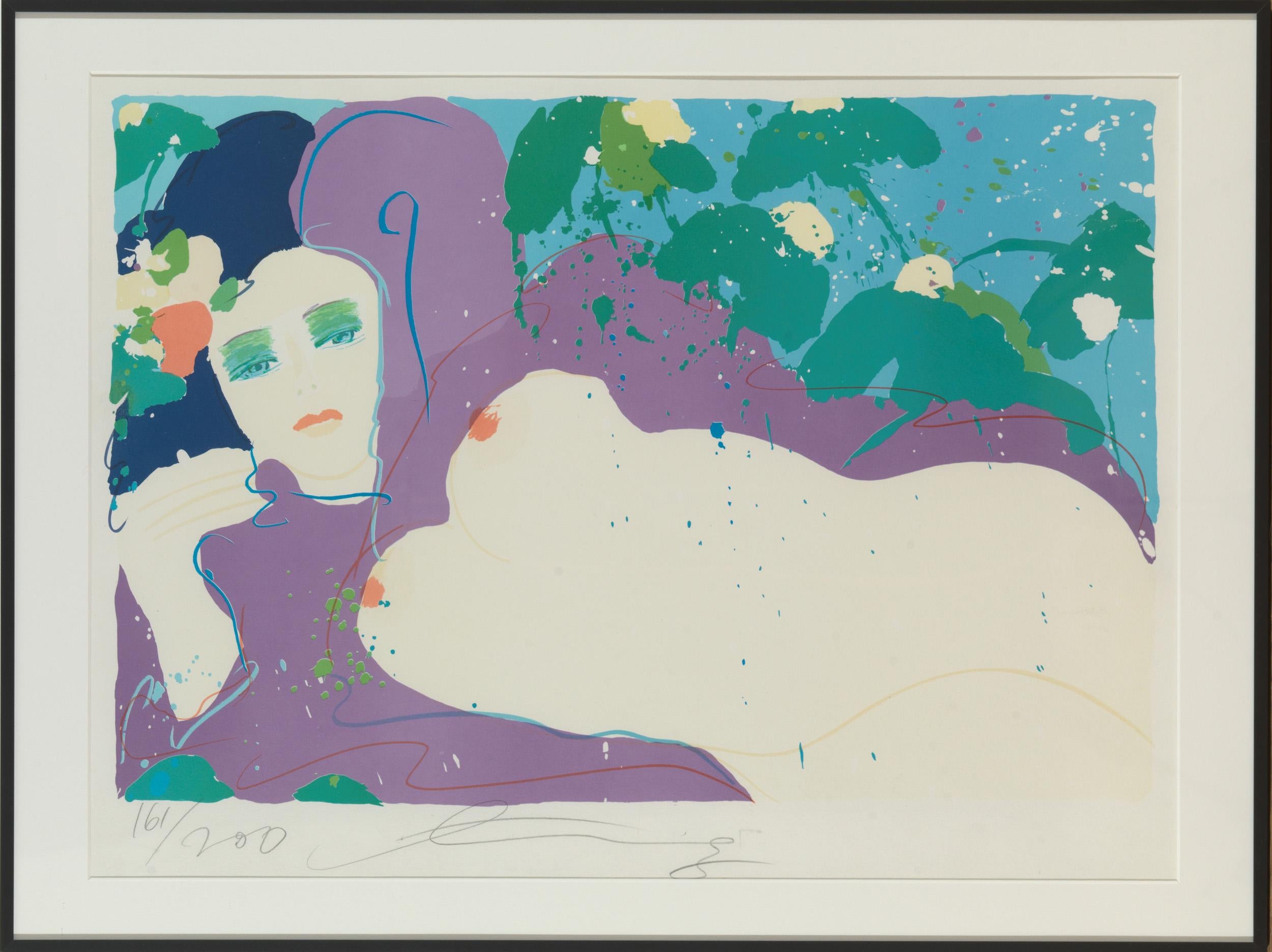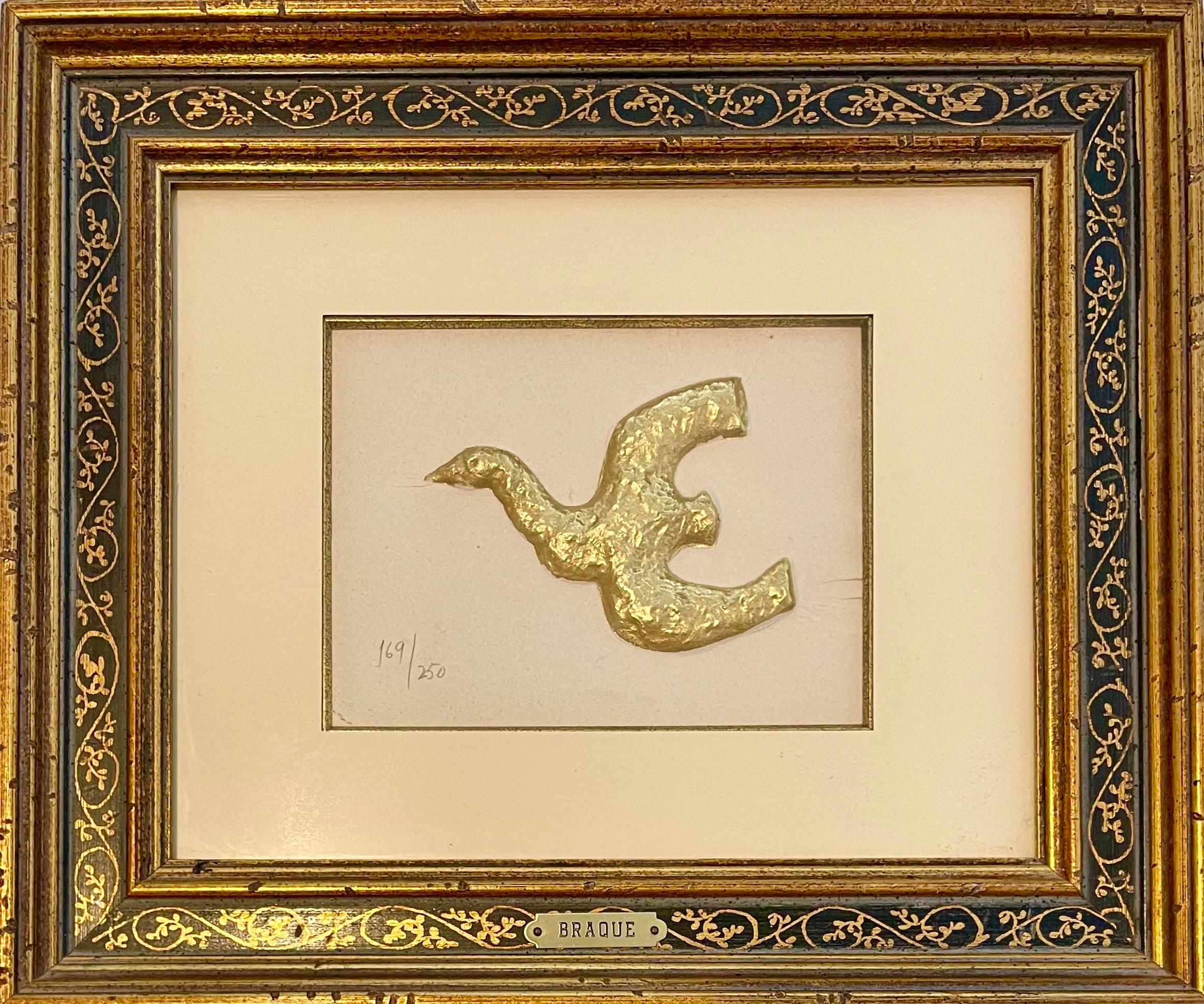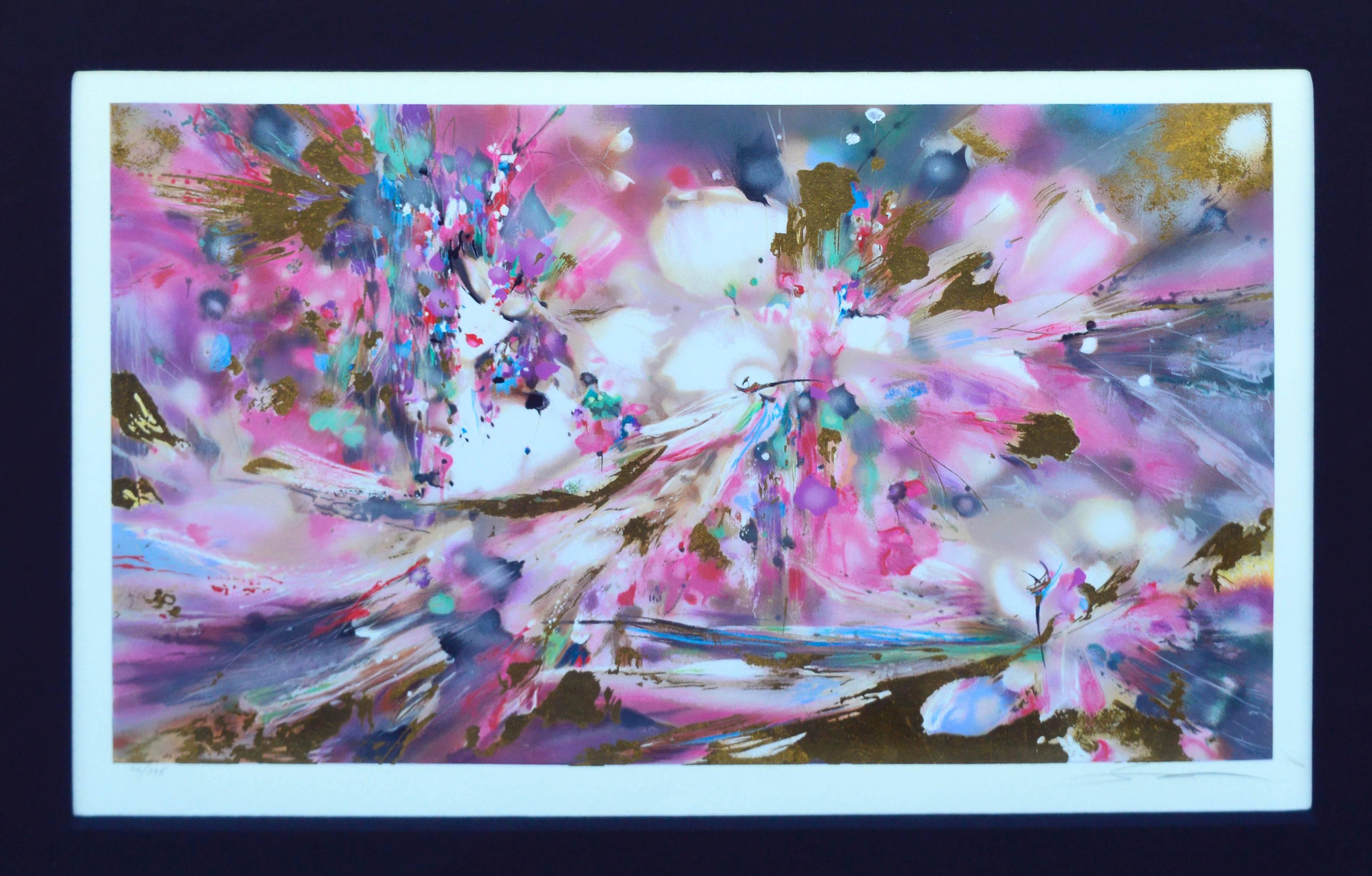Items Similar to Sabat - Limoges Porcelain Blue and Gold
Want more images or videos?
Request additional images or videos from the seller
1 of 9
(after) Salvador DaliSabat - Limoges Porcelain Blue and Gold1968
1968
About the Item
Limoges porcelain in "Bleu de Sèvres" and gold.
Artist: Salvador Dali
Exclusive limited edition to 2000 copies "Raynaud & Co. Limoges", France, 1968.
"Sabat" drawn by Salvador Dalí. Print signed.
Plate Signed in the back of the plate
Dimensions: Diameter: 26 cm
Edited by Salins Earthenware
Sold in its original box
The company "Raynaud-Limoges" specialized in the production of porcelain products in small runs, among the company's customers - crowned people and representatives of the old aristocratic families of Europe.
Dali - the Prodigy Child without an Exam.
Salvador Dali was born as the son of a prestigious notary in the small town of Figueras in Northern Spain. His talent as an artist showed at an early age and Salvador Felipe Jacinto Dali received his first drawing lessons when he was ten years old. His art teachers were a then well known Spanish impressionist painter, Ramon Pichot and later an art professor at the Municipal Drawing School. In 1923 his father bought his son his first printing press.
Dali began to study art at the Royal Academy of Art in Madrid. He was expelled twice and never took the final examinations. His opinion was that he was more qualified than those who should have examined him.
In 1928 Dali went to Paris where he met the Spanish painters Pablo Picasso and Joan Miro. He established himself as the principal figure of a group of surrealist artists grouped around Andre Breton, who was something like the theoretical "schoolmaster" of surrealism. Years later Breton turned away from Dali accusing him of support of fascism, excessive self-presentation and financial greediness.
By 1929 Dali had found his personal style that should make him famous the world of the unconscious that is recalled during our dreams. The surrealist theory is based on the theories of the psychologist Dr. Sigmund Freud. Recurring images of burning giraffes and melting watches became the artist's surrealist trademarks. His great craftsmanship allowed him to execute his paintings in a nearly photo-realistic style. No wonder that the artist was a great admirer of the Italian Renaissance painter Raphael.
Salvador Dali and Gala.
Meeting Gala was the most important event in the artist's life and decisive for his future career. She was a Russian immigrant and ten years older than Dali. When he met her, she was married to Paul Eluard.
Gala decided to stay with Dali. She became his companion, his muse, his sexual partner, his model in numerous art works and his business manager. For him she was everything. Most of all Gala was a stabilizing factor in his life. And she managed his success in the 1930s with exhibitions in Europe and the United States.
Gala was legally divorced from her husband in 1932. In 1934 Dali and Gala were married in a civil ceremony in Paris and in 1958 in church after Gala's former husband had died in 1952. However from around 1965 on, the couple was seen less frequently together. But Gala continued to manage Dali's business affairs.
1933 Salvador Dali had his first one-man show in New York. One year later he visited the U.S. for the first time supported by a loan of US$500 from Pablo Picasso. To evade World War II, Dali chose the U.S.A. as his permanent residence in 1940. He had a series of spectacular exhibitions, among others a great retrospective at the Museum of Modern Art in New York.
Besides creating a number of great paintings, Dali caused the attention of the media by playing the role of a surrealist clown. He made a lot of money and was contemptuously nicknamed Avida Dollars (greedy for dollars) by Andre Breton.
Dali became the darling of the American High Society. Celebrities like Jack Warner or Helena Rubinstein gave him commissions for portraits. His art works became a popular trademark and besides painting he pursued other activities - jewelry and clothing designs for Coco Chanel or film making with Alfred Hitchcock.
The Classic Period After World War II
In 1948 Dali and Gala returned to Europe, spending most of their time either in their residence in Lligat or Spain or in Paris or France or in New York. Dali developed a lively interest in science, religion and history. He integrated things into his art that he had picked up from popular science magazines.
Another source of inspiration were the great classical masters of painting like Raphael, Velasquez or the French painter Ingres. The artist commented his shift in style with the words: "To be a surrealist forever is like spending your life painting nothing but eyes and noses."
In 1958 the artist began his series of large sized history paintings. He painted one monumental painting every year during the summer months in Lligat. The most famous one, The Discovery of America by Christopher Columbus, can be seen at the Dali Museum in St. Petersburg in Florida. It is breath-taking. The artist's late art works combine more than ever his perfect and meticulous painting technique with his fantastic and limitless imaginations.
Salvador Dali is the only known artist who had two museums dedicated exclusively to his works at lifetime.
Dali Museum in St. Petersburg, Florida
The Dali Museum in St. Petersburg in Florida or U.S.A. was founded in 1971 by the Dali collector A. Reynolds Morse and his wife Eleanor. The collection was first exhibited in a building adjacent to their home in Cleveland/Ohio.
In 1982, the museum was moved to St. Petersburg in Florida. It hosts 95 oil paintings including six of Dali's eighteen large-sized historical paintings.
Dali Museum-Theater in Figueres, Spain.
The Dali Museum-Theater in Figueres, Spain was the former Municipal Theater of Figueres. In 1918, when Salvador Dali was only fourteen years old, it had shown his first public exhibition.
Since 1970 the artist had dedicated his energy to transform the former Municipal Theater into a museum and art gallery. In 1974 the Theatro Museo Dali was officially opened.
1980 Dali was forced to retire due to palsy, a motor disorder, that caused a permanent trembling and weakness of his hands. He was not able to hold a brush any more. The fact that he could not follow his vocation and passion of painting and the news of Gala's death in 1982 left him with deep depressions.
After Gala's death he moved to Pubol, a castle, he had bought and decorated for Gala. In 1984, when he was lying in bed, a fire broke out and he suffered sever burns. Two years later, a pacemaker had to be implanted.
Towards the end of his life, Dali lived in the tower of his own museum where he died on January 23, 1989 from heart failure.
- Creator:(after) Salvador Dali (1904 - 1989, Spanish)
- Creation Year:1968
- Dimensions:Height: 0.79 in (2 cm)Width: 10.24 in (26 cm)Depth: 10.24 in (26 cm)
- Medium:
- Movement & Style:
- Period:
- Condition:
- Gallery Location:Collonge Bellerive, Geneve, CH
- Reference Number:1stDibs: LU16122565491
About the Seller
4.9
Gold Seller
These expertly vetted sellers are highly rated and consistently exceed customer expectations.
Established in 2015
1stDibs seller since 2015
908 sales on 1stDibs
Typical response time: 2 hours
- ShippingRetrieving quote...Ships From: Collonge Bellerive, Geneve, Switzerland
- Return PolicyA return for this item may be initiated within 7 days of delivery.
More From This SellerView All
- Venus - Limoges Porcelain Blue and GoldBy (after) Salvador DaliLocated in Collonge Bellerive, Geneve, CHLimoges porcelain in "Bleu de Sèvres" and gold. Artist: Salvador Dali Exclusive limited edition to 2000 copies "Raynaud & Co. Limoges", France, 1968. "Silhouette de Faust" drawn by...Category
1960s Modern Mixed Media
MaterialsPorcelain
- Faust - Limoges Porcelain Blue and GoldBy (after) Salvador DaliLocated in Collonge Bellerive, Geneve, CHLimoges porcelain in "Bleu de Sèvres" and gold. Artist: Salvador Dali Exclusive limited edition to 2000 copies "Raynaud & Co. Limoges", France, 1968. "Faust" drawn by Salvador Dalí...Category
1960s Modern Mixed Media
MaterialsPorcelain
- Jean Picart Le Doux - Sunshine - Original Salins EarthenwareBy Jean Picart Le DouxLocated in Collonge Bellerive, Geneve, CHOriginal Salins Earthenware Plate Artist: Jean Picart Le Doux Title: Sunshine Signed in the back of the plate Dimensions: Diameter: 24 cm Edited by Salins Earthenware Jean Picart le Doux, French (1902 - 1982) Jean Picart Le Doux, born in Paris January 31, 1902 and died in 1982, was a French painter and painter-cartonnier the revival of contemporary tapestry. He is the son of the painter Charles Picart Le Doux (1881-1959). Without specialized training, he made his debut in bookbinding and publishing, and then he turned to advertising and graphic arts and publishing his first works in 1935. His first tapestry dating from 1943 after winning the Grand Prix of the theater poster exhibition in the imaging. He met Jean Lurçat and, with Marc Saint-Saëns, gather around him in 1947 for the Association of painters cardboard tapestry. In 1950, he projects the idea of the Alliance Graphique Internationale, during the meeting with exhibitors of an exhibition of their work in Basel, two other French designers Jean Jacques Colin and Nathan, and two graphic designers Swiss, Fritz Buhler and Donald Brown...Category
1960s Modern Mixed Media
- Marc Chagall - Revolution - Original 1960s Poster for Galiera MuseumBy Marc ChagallLocated in Collonge Bellerive, Geneve, CHafter Marc CHAGALL (1887 - 1985) Poster for "Les peintres témoins de leur temps Musée Galiera" 1963 Created by Charles Sorlier after Chagall's 1937 painting...Category
1960s Modern Figurative Prints
- Paul Jouve - Eagle - Original EngravingBy Paul JouveLocated in Collonge Bellerive, Geneve, CHPaul Jouve - Eagle - Original Engraving Editions Rombaldi, Paris, 1950. Copy on velin creme de Rives Artwork by Paul Jouve. Original copper engraving heightened with pochoir. Paul...Category
1950s Modern Animal Prints
MaterialsEngraving
- Pablo Picasso - The Painter - Original LithographBy Pablo PicassoLocated in Collonge Bellerive, Geneve, CHPablo Picasso - Original Lithograph Title: Painter and his Model From the illustrated book "Regards sur Paris" (Paris: André Sauret, 1962) Edition of 180 Individual prints were not s...Category
1960s Modern Portrait Prints
MaterialsLithograph
You May Also Like
- The Magicians Message From Cuevas' ComediesBy José Luis CuevasLocated in Delray Beach, FLThe Magicians Message From Cuevas' Comedies. Screenprint with collage additions and five lithographs from a portfolio of ten lithographs (one with screenprint and embossing, one with embossing) and five screenprints (two double-sided, one with collage additions). Pencil signed and dated 1971, edition 84/100, blindstamp visible, published by Collector's Press, San Francisco. Framed under Plexiglas. Jose Louis Cuevas was born in Mexico City in 1933 -2017. A master draftsman, Jose Luis Cuevas played a pivotal role in Latin America's drawing and printmaking renaissance of the sixties and seventies. He is also associated with Latin America's neofigurative movement, along with artists such as Fernando Botero and Antonio Segui. By the age of fourteen, he had illustrated numerous periodicals and books and had had his first exhibition in Mexico City. In 1953 Cuevas published La cortina del nopal (The Cactus Curtain), an article condemning aspects of the Mexican Mural movement and advocating greater artistic freedom. This philosophy inspired the founding in 1960 of the group Nueva Presencia, which he joined for a brief time. It promoted individual expression and figurative art reflecting the contemporary human condition. Cuevas' work was influenced by the graphic art of Goya and Picasso as well as by Posada and Orozco, whose representations of deformed creatures, degraded humanity and prostitutes were of particular thematic interest. Over the years, he has paid homage to his favorite painters as well as writers, such as Dostoevsky, Kafka, Quevedo and Sade, in numerous series of drawings and prints. Cuevas has said that his drawing represents the solitude and isolation of contemporary man and man's inability to communicate. It is for this reason that he often distorts and transforms the human figure to the point of uniqueness. Cuevas has had solo exhibitions in museums and galleries throughout the world including the: University of Texas, Austin, 1961, the San Francisco Museum of Art, California,1970, the Museo de Arte Moderno, Mexico City, 1972, Museo de Arte Contemporaneo, Caracas, 1974, Phoenix Art Museum, Arizona, 1975, Musee d'Art Moderne, Paris, 1976. His work was included in Four Masters of Line: Jose Luis Cuevas, Alexander Calder, Stuart Davis, and Morris Graves, Musee de la Napoule, France, 1957 and in The Emergent Decade, Cornell University and Solomon R. Guggenheim Museum, New York, 1965. Among his many awards are First International Prize for Drawing, Biennial of Sao Paulo, 1959, First Prize, International Black and White Exhibition, Lugano, Switzerland, 1962, First International Prize for Printmaking, Triennial of Graphic Arts, New Delhi, India, 1968, First Prize, III Latin American Print...Category
1970s Modern Figurative Prints
MaterialsLithograph, Etching
- Walasse Ting (Shanghai, 1929 - New York, 2010 ) Night, LithographyBy Walasse TingLocated in brussel, BEThis beautiful lithograph is created by Walasse Ting (1929-2010), an American-Chinese artist known for his brightly coloured paintings of cats, erotic nudes, and flowers. Measureme...Category
Mid-20th Century American Modern Figurative Prints
MaterialsPaper
- Rare 18 Karat Gold Leaf Embossed Etching After Georges Braque L'Oiseau d'OrBy Georges BraqueLocated in Surfside, FLAfter Georges Braque (French, 1882-1963) "L'Oiseau d'Or," embossed cast-paper intaglio with 18K gold paint after Braque's Oiseau brooch design, unsigned...Category
20th Century Modern Figurative Prints
MaterialsGold Leaf
- Her Dreams AbstractLocated in Soquel, CAVibrant and arresting "Her Dreaming" is a wonderful modern abstract expressionist lithograph print by unknown artist. Signed illegibly lower right. Numbered "36/345". Image size, 20"...Category
1970s Modern Mixed Media
MaterialsMixed Media
- "The Doctor's In" Modern Pop Art Figurative 3D Hand Cut Serigraph Ed. 159/475By Charles FazzinoLocated in Houston, TXModern pop art 3 dimensional silkscreen serigraph by contemporary artist Charles Fazzino. The work features a variety of vignettes that have been combined to create a larger hospital...Category
1990s Modern Mixed Media
MaterialsMixed Media
- Alexander Emperor - Original Lithograph - 1816 ca.Located in Roma, ITAlexander Emperor is an original print realized in 1816 ca. Original mixed colored hand watercolor lithograph . Title printed on plate on the lower margin. Published by Richard Ev...Category
Early 19th Century Modern Figurative Prints
MaterialsWatercolor, Lithograph

